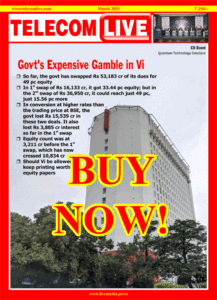SpaceX wants India’s new satcom policy to focus on access, not pricing
Elon Musk’s SpaceX wants the government to ensure that the upcoming satcom policy “focuses more on access and less on pricing” of internet-from-space services to attract top dollars from global investors and boost satellite broadband penetration across rural India.
This is since new-age broadband from space technology via numerous low-earth orbit (LEO) satellites is likely to be at least 7-to-8 times more expensive than terrestrial broadband services.
“Since satellite broadband can improve and save lives in India’s remote regions, it’s pretty important that the upcoming satcom policy focuses more on access and less on pricing,” Sanjay Bhargava, the India head of SpaceX’s Starlink operation, told a local TV channel.
Starlink’s Bhargava said an LEO-based satellite internet service, typically, requires “large numbers of such satellites to move very fast to cover the earth,” which makes it “at least 7-to-8 times more expensive than terrestrial broadband,” especially as the software requirements to manage such operations are very tough.
India’s much-awaited new Spacecom policy is likely to underline the critical role of LEO satellite system operators in boosting broadband coverage, particularly in rural India. This, even as Bharti-backed OneWeb and SpaceX prepare to launch high-speed satellite broadband services in India next year.
SpaceX recently registered a 100% owned subsidiary in India, Starlink Satellite Communications Pvt Ltd (SSCPL), which will enable them to start applying for licences, starting with trial spectrum to deploy Starlink connections in Delhi schools. This will reportedly be followed by an application for a restricted commercial licence.
SpaceX, in fact, is hopeful that marquee global investors would be keen to pump in top dollars if India can be pitched as a $1 billion satellite revenue opportunity. “If we are able to show the world that there may be around 1 million (access) points in India, where each point has the ability to pay $1,000 (Rs 7,500 approx) a year for satellite broadband, then the market (opportunity) will be $1 billion of annual revenue,” Bhargava said.
Such a potential scenario, he added, would encourage many to invest in the country’s emerging satellite broadband sector and pave the way for India’s very own satellite constellation. “India is very good in the space (segment) with a lot of talent, and if it’s able to attract capital, it’s only a matter of time when we will have a fully Indian satellite constellation,” the Starlink India head said.
Bhargava, though, said that while Starlink can play the role of a catalyst by providing satellite broadband (connectivity), it would need to work with a host of solution providers across domains, including education, industry, tourism amongst others.
Earlier this month, he had said SpaceX would start discussions with India’s telcos for potential collaborations to deliver high-speed satellite broadband services in India’s hardest-to-reach regions.
Bhargava’s comments come at a time when OneWeb, SpaceX, Amazon and the Tata-Telesat combine are readying to enter India’s relatively nascent fast broadband-from-space segment, leveraging their respective low–earth orbit (LEO) satellite constellations.
India is seen as a key emerging satellite internet market with an over $1 billion annual revenue opportunity. This is since almost 75% of rural India still does not have access to broadband as many locations are still without cellular or fibre connectivity. The LEO satellite systems are being seen as a viable alternative.



